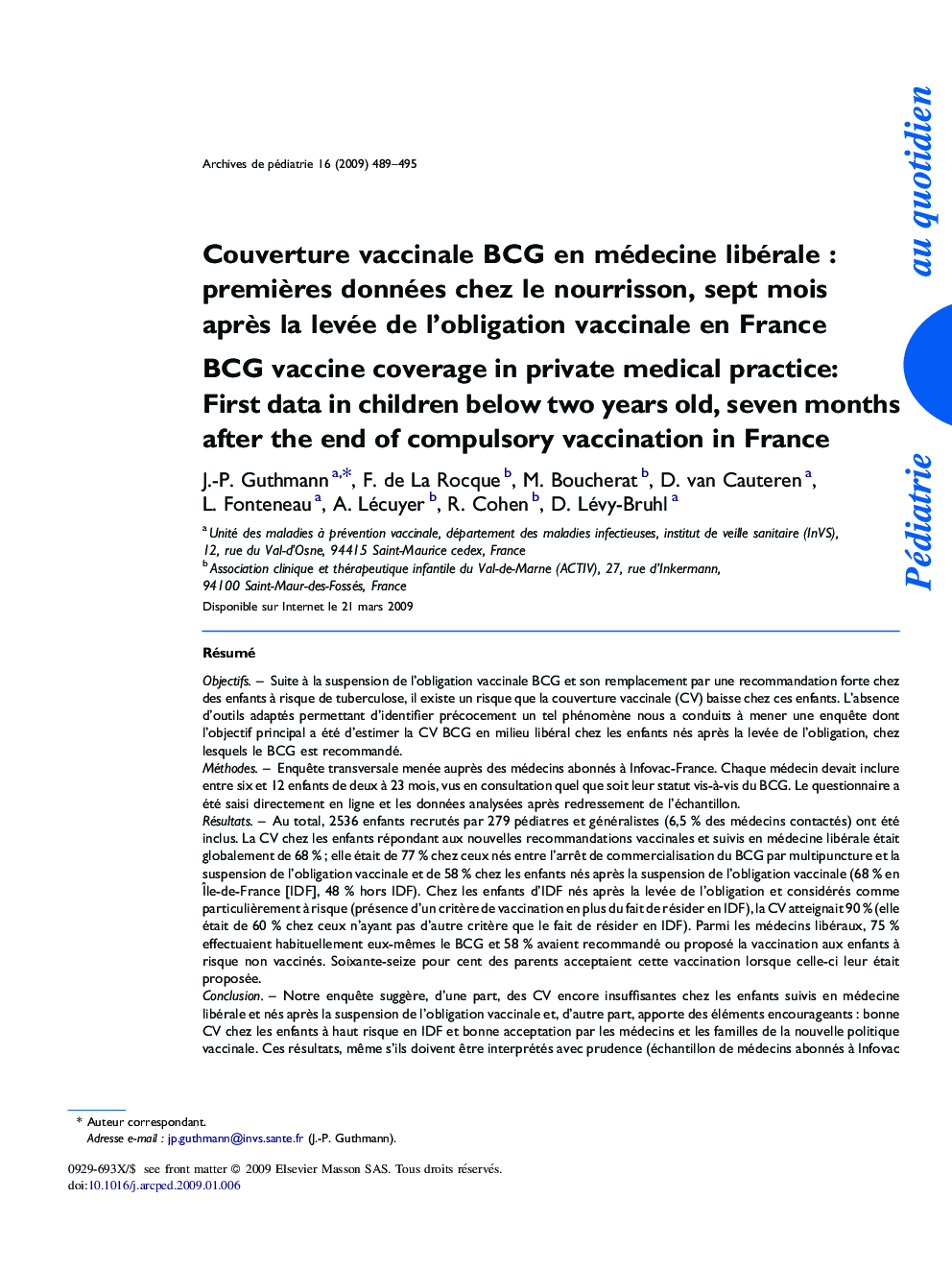| کد مقاله | کد نشریه | سال انتشار | مقاله انگلیسی | نسخه تمام متن |
|---|---|---|---|---|
| 4148991 | 1272719 | 2009 | 7 صفحه PDF | دانلود رایگان |

RésuméObjectifsSuite à la suspension de l’obligation vaccinale BCG et son remplacement par une recommandation forte chez des enfants à risque de tuberculose, il existe un risque que la couverture vaccinale (CV) baisse chez ces enfants. L’absence d’outils adaptés permettant d’identifier précocement un tel phénomène nous a conduits à mener une enquête dont l’objectif principal a été d’estimer la CV BCG en milieu libéral chez les enfants nés après la levée de l’obligation, chez lesquels le BCG est recommandé.MéthodesEnquête transversale menée auprès des médecins abonnés à Infovac-France. Chaque médecin devait inclure entre six et 12 enfants de deux à 23 mois, vus en consultation quel que soit leur statut vis-à-vis du BCG. Le questionnaire a été saisi directement en ligne et les données analysées après redressement de l’échantillon.RésultatsAu total, 2536 enfants recrutés par 279 pédiatres et généralistes (6,5 % des médecins contactés) ont été inclus. La CV chez les enfants répondant aux nouvelles recommandations vaccinales et suivis en médecine libérale était globalement de 68 % ; elle était de 77 % chez ceux nés entre l’arrêt de commercialisation du BCG par multipuncture et la suspension de l’obligation vaccinale et de 58 % chez les enfants nés après la suspension de l’obligation vaccinale (68 % en Île-de-France [IDF], 48 % hors IDF). Chez les enfants d’IDF nés après la levée de l’obligation et considérés comme particulièrement à risque (présence d’un critère de vaccination en plus du fait de résider en IDF), la CV atteignait 90 % (elle était de 60 % chez ceux n’ayant pas d’autre critère que le fait de résider en IDF). Parmi les médecins libéraux, 75 % effectuaient habituellement eux-mêmes le BCG et 58 % avaient recommandé ou proposé la vaccination aux enfants à risque non vaccinés. Soixante-seize pour cent des parents acceptaient cette vaccination lorsque celle-ci leur était proposée.ConclusionNotre enquête suggère, d’une part, des CV encore insuffisantes chez les enfants suivis en médecine libérale et nés après la suspension de l’obligation vaccinale et, d’autre part, apporte des éléments encourageants : bonne CV chez les enfants à haut risque en IDF et bonne acceptation par les médecins et les familles de la nouvelle politique vaccinale. Ces résultats, même s’ils doivent être interprétés avec prudence (échantillon de médecins abonnés à Infovac et limites méthodologiques), plaident en faveur du renforcement de la communication autour de la nouvelle politique vaccinale.
ObjectivesIn July 2007, compulsory BCG vaccination for all children was replaced by a strong recommendation to vaccinate children at high risk of tuberculosis (children who live in Île-de-France [IDF] or Guyana regions, who were born or whose parents were born in tuberculosis endemic countries, with a family history of tuberculosis or living in conditions defined as at risk by the doctor). In the absence of tools to detect an early decrease in vaccine coverage (VC) in this specific group, we conducted a survey with the main objective of measuring BCG VC in high risk children for which BCG is now recommended and who were born after the change in BCG vaccine policy.MethodsCross-sectional survey performed amongst physicians registered at “Infovac-France”, a network of general practitioners and paediatricians particularly aware of recent changes in the field of vaccinations. Each doctor was asked to recruit, during his medical consultation, between six and 12 children aged 2–7 months (born after the end of compulsory BCG vaccination in July 2007) and 8–23 months (born after the withdrawal from the market of the multipuncture form of BCG [Monovax®] in January 2006 and before the end of compulsory BCG vaccination in July 2007). Doctors were asked to fill in a structured online questionnaire. Data were standardized and analysed with Stata 9.2.ResultsA total of 2536 children, recruited by 279 general practitioners and paediatricians (6.5% of all contacted doctors), were included. VC in the target group of high risk children for who BCG is still recommended and who were seen by doctors working in a private medical practice was: overall 68%; 58% in children born after the end of compulsory BCG vaccination (68% in IDF, 48% outside IDF); 77% in those born after the withdrawal of Monovax® from the market and before the end of compulsory BCG vaccination; 90% in children living in IDF born after the end of compulsory vaccination and considered as particularly at risk of tuberculosis (presence of vaccination criteria other than residing in IDF) and 60% in the same category of children whose sole criteria for vaccination was residing in IDF. Of doctors who worked in a private medical practice: 75% used to perform the BCG vaccination themselves and 58% had recommended or suggested vaccination to children at risk who were not yet vaccinated. Seventy-six percent of parents of children at risk of tuberculosis not yet vaccinated accepted BCG vaccination when recommended by their doctor.ConclusionOur survey showed, on the one hand, insufficient VC in children seen in a private medical practice and born after the end of compulsory vaccination for whom BCG is still recommended. This should encourage the Ministry of Health to reinforce its communication concerning this new policy. On the other hand, the survey showed encouraging results concerning both the coverage of children at particularly high risk in IDF and the adherence of doctors and families to the new vaccine policy. These results should be interpreted with caution, taking into account the methodological limitations of this survey.
Journal: Archives de Pédiatrie - Volume 16, Issue 5, May 2009, Pages 489–495